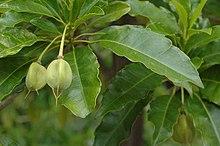| Peripentadenia | |
|---|---|

| |
| Peripentadenia mearsii | |
| Scientific classification | |
| Kingdom: | Plantae |
| Clade: | Tracheophytes |
| Clade: | Angiosperms |
| Clade: | Eudicots |
| Clade: | Rosids |
| Order: | Oxalidales |
| Family: | Elaeocarpaceae |
| Genus: | Peripentadenia L.S.Sm. |
| Type species | |
| Peripentadenia mearsii (C.T.White) L.S.Sm. | |
| Species | |
|
See text | |
Peripentadenia is a genus of two species of large trees from the family Elaeocarpaceae endemic to the rainforests of northeastern Queensland, Australia. Sometimes they have the common name quandong.
Botanists have formally described two species, both endemic to restricted areas of the Wet Tropics rainforests of northeastern Queensland.
Both species have official recognition of at risk of extinction in the wild.
Species
- Peripentadenia mearsii (C.T.White) L.S.Sm. Buff or Grey Quandong – endemic to a restricted area of the Wet Tropics rainforests
- Synonym and base name: Actephila mearsii C.T.White
- Queensland government official "near threatened" species conservation status.
- Peripentadenia phelpsii B.Hyland & Coode – endemic to a very restricted part of the rainforests of the Mossman area of the Wet Tropics
- Queensland government official "vulnerable" species conservation status.
References
- ^ Smith, Lindsay S. (1957). "New species of and notes on Queensland plants - II". Proceedings of the Royal Society of Queensland. 68: (43–) 45–50. Retrieved 10 January 2014.
- ^ "Peripentadenia%". Australian Plant Name Index (APNI), Integrated Botanical Information System (IBIS) database (listing by % wildcard matching of all taxa relevant to Australia). Centre for Plant Biodiversity Research, Australian Government. Retrieved 10 January 2014.
- ^ F.A.Zich; B.P.M.Hyland; T.Whiffen; R.A.Kerrigan (2020). "Elaeocarpaceae". Australian Tropical Rainforest Plants Edition 8 (RFK8). Centre for Australian National Biodiversity Research (CANBR), Australian Government. Retrieved 21 June 2021.
- ^ Cooper, Wendy; Cooper, William T. (June 2004). Fruits of the Australian Tropical Rainforest. Clifton Hill, Victoria, Australia: Nokomis Editions. p. 163. ISBN 9780958174213. Retrieved 21 June 2021.
- ^ Hyland, Bernie P. M.; Coode, Mark J. E. (1982). "A second species for the Australian genus Peripentadenia (Elaeocarpaceae)". Kew Bulletin. 36 (4). pp. 741–745, figs 1-2. Bibcode:1982KewBu..36..741H. doi:10.2307/4117917. JSTOR 4117917.
- Coode, Mark J. E. (1987). "Crinodendron, Dubouzetia and Peripentadenia, closely related in Elaeocarpaceae". Kew Bulletin. 42 (4). pp. (777–) 812-813 (–814), fig. 14. Bibcode:1987KewBu..42..777C. doi:10.2307/4109929. JSTOR 4109929.
- ^ F.A.Zich; B.P.M.Hyland; T.Whiffen; R.A.Kerrigan (2020). "Peripentadenia mearsii". Australian Tropical Rainforest Plants Edition 8 (RFK8). Centre for Australian National Biodiversity Research (CANBR), Australian Government. Retrieved 21 June 2021.
- ^ F.A.Zich; B.P.M.Hyland; T.Whiffen; R.A.Kerrigan (2020). "Peripentadenia phelpsii". Australian Tropical Rainforest Plants Edition 8 (RFK8). Centre for Australian National Biodiversity Research (CANBR), Australian Government. Retrieved 21 June 2021.
- ^ Queensland Government (27 September 2013). "Nature Conservation (Wildlife) Regulation 2006" (PDF). Nature Conservation Act 1992. Online, accessed from www.legislation.qld.gov.au. Australia. Retrieved 14 December 2013.
Cited works
- F.A.Zich; B.P.M.Hyland; T.Whiffen; R.A.Kerrigan (2020). "Australian Tropical Rainforest Plants Home". Australian Tropical Rainforest Plants Edition 8 (RFK8). Centre for Australian National Biodiversity Research (CANBR), Australian Government. Retrieved 21 June 2021.
| Taxon identifiers | |
|---|---|
| Peripentadenia | |
This Oxalidales article is a stub. You can help Misplaced Pages by expanding it. |
This Australian rosid article is a stub. You can help Misplaced Pages by expanding it. |